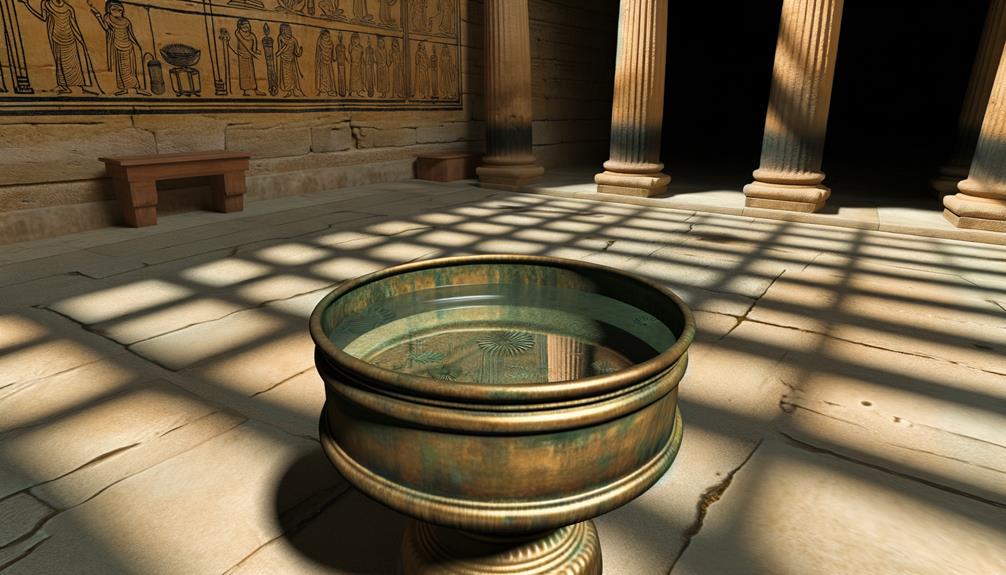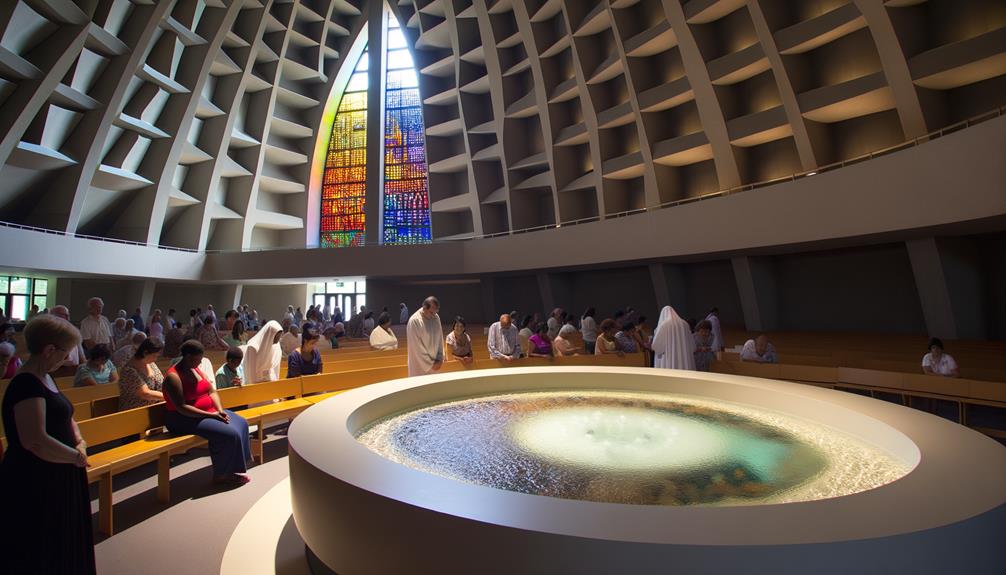Laver Meaning in the Bible: Purification Rituals
In the Bible, the laver is an essential bronze basin used for ceremonial washing, symbolizing purity and sanctification. Crafted from bronze mirrors donated by women, it first appears in Exodus 30:18 for use in the Tabernacle.
Priests were required to wash their hands and feet in the laver before performing sacred duties (Exodus 30:19-21), emphasizing the importance of ritual cleanliness. In Solomon’s Temple, it was referred to as the ‘Sea of cast metal’ (1 Kings 7:23).
Reflecting the need for physical and spiritual purification, the laver’s significance extends to contemporary practices such as baptism, revealing profound theological insights into worship and holiness.

Laver Meaning in the Bible: Symbol of Cleansing and Preparation for Worship
| Term | Laver |
|---|---|
| Biblical Reference | Exodus 30:18–21; Exodus 38:8 |
| Definition | A large bronze basin used for ceremonial washing in the Tabernacle |
| Purpose | Priests washed their hands and feet before ministering before the Lord |
| Symbolism | Represents spiritual cleansing, holiness, and preparation for God’s presence |
| Spiritual Insight | Emphasizes the need for purity before serving or approaching God |
| Modern Application | Encourages spiritual readiness, repentance, and inner cleanliness in worship |
Biblical References

The term ‘laver‘ frequently appears in biblical texts, primarily within the context of the Tabernacle and Temple rituals as detailed in the Old Scriptures.
It is prominently featured in the Book of Exodus, where God instructs Moses on the construction of a bronze laver for the Tabernacle (Exodus 30:18). This laver was utilized by priests for ceremonial washing before performing sacrifices, symbolizing purity and sanctification (Exodus 30:19-21).
Further references are found in 1 Kings 7:23 and 2 Chronicles 4:2, describing the ‘Sea of cast metal’ in Solomon’s Temple, serving a similar purificatory function.
Such texts underscore the laver’s role in ritual cleanliness, integral to the sanctity of worship practices in ancient Israelite religious life.
Construction and Design

Moving from the scriptural significance of the laver, attention must be directed to its construction and design as specified in the biblical texts.
According to Exodus 30:17-21, the laver was made of bronze, along with its base, designed to hold water for ritual purification. It was fashioned from the mirrors of the women who served at the entrance to the Tent of Meeting (Exodus 38:8).
The use of bronze symbolizes strength and purification, aligning with the laver’s purpose. Detailed instructions emphasize the importance of craftsmanship and material, underscoring the sacred nature of the object.
The precise design reflects its integral role in maintaining the sanctity and purity required for the priests to perform their duties within the Tabernacle.
Role in Rituals

How did the laver function within the intricate system of ritual purification in the Tabernacle, particularly in the daily life of the priests? The laver, positioned between the altar and the Tabernacle itself, served as an essential instrument in maintaining ritual purity.
Priests, as prescribed in Exodus 30:18-21, were required to wash their hands and feet before performing any sacred duties. This act not only guaranteed physical cleanliness but also symbolized a deeper, spiritual readiness to serve.
“`markdown
| Aspect | Emotional Impact |
|---|---|
| Daily Ritual | Reverence and Discipline |
| Physical Cleansing | Purity and Holiness |
| Spiritual Readiness | Devotion and Sanctification |
“`
The laver’s role underscored the importance of purity in approaching the divine, making it an indispensable element of the sacred rituals.
Symbolism of Purification

Positioned at the heart of ritual practice, the laver not only facilitated physical purification for the priests but also symbolized the profound theological concept of spiritual cleansing.
This symbolism is deeply rooted in several scriptural references:
- Exodus 30:18-21 – The laver is explicitly commanded for use in washing, signifying the necessity of purity before approaching God.
- Psalm 51:7 – The plea for purification with hyssop mirrors the ritualistic cleansing, underscoring inner purity.
- John 13:10 – Jesus’ washing of the disciples’ feet represents ongoing spiritual cleansing.
- Hebrews 10:22 – The call to draw near with a pure heart parallels the laver’s role in ensuring the priests’ sanctity.
Thus, the laver’s presence underscores a broader divine mandate for holiness.
Spiritual Significance

The laver’s spiritual significance extends beyond its physical function, embodying a divine instrument for the continual sanctification of God’s chosen servants.
In Exodus 30:18-21, the Lord commands Moses to create a bronze basin for Aaron and his sons to wash their hands and feet before entering the Tabernacle, emphasizing the necessity of holiness.
This ritual cleansing symbolizes the purification of one’s heart and mind, aligning with Psalm 24:3-4, which questions, ‘Who may ascend the hill of the Lord?’ and answers, ‘He who has clean hands and a pure heart.’
Consequently, the laver acts as an indication of the perpetual need for spiritual purification, underscoring the importance of maintaining a sanctified relationship with the Divine.
Contemporary Relevance

In contemporary Christian worship, the symbolism of the laver continues to manifest through practices emphasizing spiritual cleansing and renewal, echoing the biblical call for purity seen in Exodus 30:18-21.
Modern liturgical elements, such as baptismal fonts and ceremonial washings, encapsulate the essence of the laver, serving as tangible reminders of the believer’s need for continual sanctification.
Integrating the laver’s symbolism into present-day rituals underscores the timeless relevance of ancient scriptural principles in nurturing spiritual growth and communal holiness.
Symbolism in Modern Worship
Amidst the evolving landscape of modern worship, the biblical laver’s symbolism finds resonance in contemporary practices, reflecting themes of purification and preparation for divine encounter. Rooted in Exodus 30:18-21, the laver’s symbolism extends into modern liturgical settings, emphasizing inner sanctification.
The following points illustrate this continuity:
- Baptismal Fonts: Modern churches often use fonts as physical representations of spiritual cleansing.
- Ritual Hand Washing: Some traditions maintain the practice of hand washing before services, echoing the laver’s purpose.
- Meditative Practices: Reflective practices before worship serve as a metaphorical washing, preparing the heart and mind.
- Communion Preparation: Congregational rituals for internal reflection and repentance mirror the laver’s role in readiness for divine encounter.
This enduring symbolism enriches contemporary worship with profound theological depth.
Spiritual Cleansing Rituals
Modern spiritual cleansing rituals, deeply rooted in biblical tradition, continue to hold significant relevance in contemporary worship practices.
In Exodus 30:18-21, God commanded Moses to construct a laver for the priests to wash their hands and feet, symbolizing purification before approaching the holy. This act of cleansing is echoed in New Covenant practices such as baptism (John 3:5), where water signifies spiritual rebirth and purification from sin.
Today, many Christian denominations incorporate rituals of washing, anointing, and symbolic purification into their liturgies, emphasizing the ongoing need for spiritual renewal and sanctification.
These practices serve to remind believers of their continual need for God’s grace and the transformative power of repentance and faith.
Laver in Contemporary Practice
The concept of the laver, originating from biblical instructions, continues to find symbolic and practical significance in contemporary Christian worship, underscoring the enduring importance of ritual purification and spiritual readiness. This ancient practice, deeply rooted in Exodus 30:17-21, serves as a reminder of the necessity of cleansing before approaching the divine.
In modern contexts, the laver’s essence is preserved through:
- Baptismal Fonts: Emphasizing the washing away of sin and the initiation into the faith.
- Holy Water Fonts: Positioned at church entrances to symbolize purification upon entering sacred space.
- Foot Washing Ceremonies: Practiced in specific liturgical traditions, reflecting servitude and humility (John 13:14-15).
- Personal Devotions: Rituals of cleansing in private prayer, echoing the biblical call for purity (James 4:8).
Conclusion
The laver, akin to a sacred mirror reflecting divine purity, holds profound theological significance within biblical texts. Its intricate construction and pivotal role in rituals underscore the importance of purification before approaching the sacred.
Symbolizing spiritual cleansing, the laver serves as a tangible reminder of the need for holiness. Even today, its legacy resonates, urging contemporary believers to seek continual purification.
Consequently, the laver remains a timeless emblem of spiritual renewal and sanctification.






